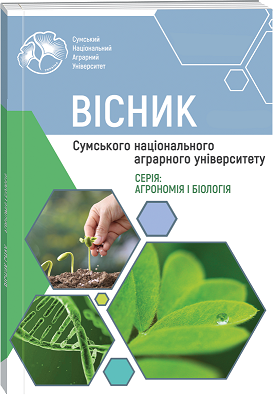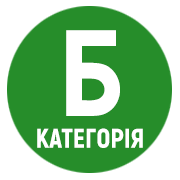MANIFESTATION AMONG THE OFF SPRINGS OF THE FIRST TUBER GENERATION OF HYBRIDS FROM INTRASPECIES AND INTERSPECIES CROSSINGS OF THE MIDDLE MASS OF TUBERS
Abstract
The results of the study indicate a higher variation of the average weight of tubers in varieties-components of crossing (18–84 g), compared with interspecific hybrids, their backcrosses (27–46 g). In contrast, the maximum value of the lower limit of population limits from intraspecific crossing was 15 g, and from backcrossing in five combinations (25 % of all) – 20 g. The same applied to the upper limit of limits, respectively, 130 and 205 g. It is proved that the difference between the average population manifestation of the indicator is much larger among the combinations from backcrossing (25 g with a range of 23–48 g) than from intraspecific crosses, respectively, 11 and 30–41 g. The greatest influence of pollinators on the manifestation of the average mass of tubers among the offspring with the participation of the Podolia variety was established. The difference between the combinations was 8 g. Population blocks with varieties Tiras (maternal form) and Podolyanka (pollinator – 7 g) were only slightly inferior to it. traits in the offspring with the participation of varieties Basis and Podolia (difference 5 g) and Stream and Podolia with a difference of 11 g Only in one combination from intraspecific crosses and in four from backcrossing hybrids with an average weight of tubers of 100 g and more were isolated. Only in seven populations (29% of the total) was true heterosis positive, although this did not apply to any of the intraspecific origin. In 20 combinations, the degree of transgression was positive and only three did not show the frequency of transgression.
References
2. Banadysev, S. A., Starovojtov, A. M., Koljadko, I. I., Mahan'ko, V. L., Fando, V. V., & Kozlova, L. I. (2003). Metodicheskie rekomendacii po specializirovannoj ocenke sortov kartofelja [Methodical recommendations for specialized assessment of potato varieties]. Ministerstvo sel'skogo hozjajstva i prodovol'stvija Respubliki Belarus'. Minsk, 70 (in Russian).
3. Bondus, R. O., Podhaietskyi, A. A., & Tokman, V. S. (2009). Otsinka serednorannikh sortiv kartopli – skladovykh kolektsii Ustymivskoi doslidnoi stantsii [Evaluation of middle-early varieties of potatoes – components of the collection of Ustymivka station]. Henetychni resursy roslyn, 7, 164–173 (in Ukrainian).
4. Bradshaw, J. (2009). Potato breeding at the Scottish Plant Breeding Station and the Scottish Crop Research Institute: 1920-2008. Potato Res., 52, 141–172. doi: 10.1007/s11540-009-9126-5.
5. Castaneda-Alvares, N. P., de Haan, S., Juarez, H., Khoury, C. K., Achicanoy, H. A., Sosa, C. C., Bernau, V. V., Salas, A., Heider, B., Sinon, R., Maxted, N., & Spooner, D. (2015). Ex situ conservation priorities for the wild relatives of potato (Solanum L. section Petota). PLoS ONE, 10(4), doi: 10/1371/journal.pone.0122599.
6. Gopal, J., Gaur, P. C., & Rana, M. S. (1992). Early generation selection for agronomic characters in a potato breeding programme. Theor. Apll. Gen., 84, 709–713.
7. Kiru, S. D., & Rogozina, E. V. (2017). Mobilization, conservation and study of cuktivated and wild potato genetic resources. Vavilov journal of genetics and breeding. 2017. 21(1), 7–15. doi: 10.18699/VJ17.219.
8. Kovalenko, V. M. (2013). Adaptyvnyi potentsial sortiv kartopli riznykh selektsiinykh ustanov [Adaptive potential of potato verieties of different breeding institutions]. Dys. k.s.-h.n: 06.01.05. Sumskyi NAU, Sumy, 193 (in Ukrainian).
9. Kravchenko, N. V., Podhaietskyi, A. A, & Sobran, I. V. (2019). The average weight of tubers of the second vegetative generation of offspring from backcrossing of complex interspecific hybrids of potatoes. Proceedings of the VIII International Scientific Conference "Breeding and Genetic Science and Education". March 18-20, 2019. Uman, 114–115 (in Ukrainian).
10. Meenakshi, Kumari; Manoj, Kumar; Shcshcank, Shekhar Solankey. (2018). Breeding Potato for Quality Improvement. Submited: May 8th 2017 Reviewed: October 5-th 2017 Published; June 6th 2018. doi: 10.5772/intechopen.71482.
11. Mendoza, H. A., & Haynes, F. L. (1973). Some aspects of breeding and inbreeding in potatoes. Am. Pot. J., 50. 216–222.
12. Metodychni rekomendatsii shchodo provedennia doslidzhen z kartopleju [Methodical recommendations for research with potatoes] (2003). Nemishaieve, 83 (in Ukrainian).
13. Moller, K. H. (1965). Untersuchungen an Testkreuzungen zur Auswahl geeigneter Eltern und Kombinationen in der Kartoffelziichtung. Diss. Dt. Akad. Land-wirtschaftswiss., Berlin (in German).
14. Osypchuk, A. A. (2002). Henetychnyi potentsial kartopli [Genetic potential of potatoes]. Kartoplia. T1, Kyiv, 203–204 (in Ukrainian).
15. Podhaietskyi, A. A. (2012). Mezhvidovaja gibridizacija v selekcii kartofelja v Ukraine [Interspecies crosses in potato breeding in Ukraine]. Vavilov journal of genetics and breeding. 2, 16, 471–479 (in Russian).
16. Podhaietskyi, A. A., Kovalenko, V. M., & Kyienko, Z. B. (2014). Ocinka sortiv selekcii' Instytutu kartopljarstva NAAN za seredn'oju masoju bul'b u riznyh umovah [Evaluation of varieties of selection of the Institute of Potato NAAS on the average weight of tubers in different conditiond]. Kartopliarstvo Ukrainy, 3-4(36-37), 25–31 (in Ukrainian).
17. Podhaietskyi, A. A., Kravchenko, N. V., & Sobran, I. V. (2018). The average weight of offspring tubers from backcrossing of complex interspecific potato hybrids in the first tuber generation. Proceedings of the scientific conference "Current status and prospects for the development of selection and seed production of potatoes." July 10, 2018, Moscow. NIIKH, 71–79 (in Russian).
18. Rokytskyi, P. F. (1973). Byolohycheskaya statystyka. Vysheishaia shkola, Mynsk, 319.
19. Ross, H. (1986). Potato breeding – problems and perspectives. Paul Parey, Berlin and Hamburg, 132.
20. Rowe, P. R. (1967). Performance and variabiality of diploid and tetraploid potato families. Am. Pot. J., 44, 263–271.
21. Sainakova, A. B., Romanova, M. S., Krasnykov, S. N., Lytvynchuk, O. V., Alekseev, A. Y., Nykulyn, A. V., Terenteva, E. V. (2018). Issledovanie kollekcionnyh obrazcov kartofelja na nalichie geneticheskih markerov ustojchivosti k fitopatogenam [Study of collection potato samples for the presensce of genetic markers of resistance to phytopathogens]. Vavylovskyi zhurnal henetyky y selektsyy, 22(1), 18–24 (in Russian). doi: 10.18699/VJ18.326.
22. Schick, R., & Hopfe, A. (1962). Die Zuchtung der Kartoffel. Die Kartoffel. Bd. II. Berlsn: Veb. Dtsch.Landwirtsch, 1462 (in German).
23. Slater, A., Cogan, N., Benjamin, J., Hayes, B., Kee, S., Finlay, M., Dale, B., Gleen, J., Bryan, J., & Foster, W. (2014). Improving dreeding tfficiency in potato using molecular and Quantitative genetics. Theor. Appl. Genet., 127(11), 2279–2292. doi: 10.1007/s00122-014-2386-8.
24. Skiebe, K. (1977). Die genetischen Ursachen von Hybrideffekten. Biol. Zentialbl. 96, 303–319 (in German).

 ISSN
ISSN  ISSN
ISSN 


